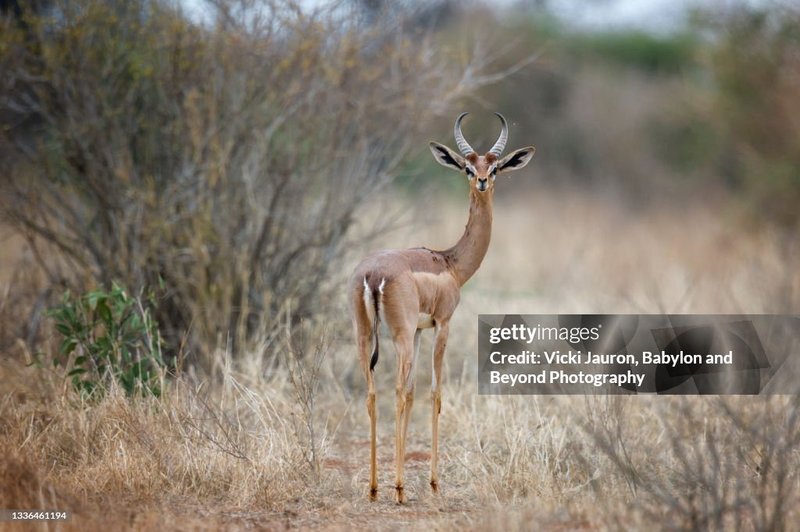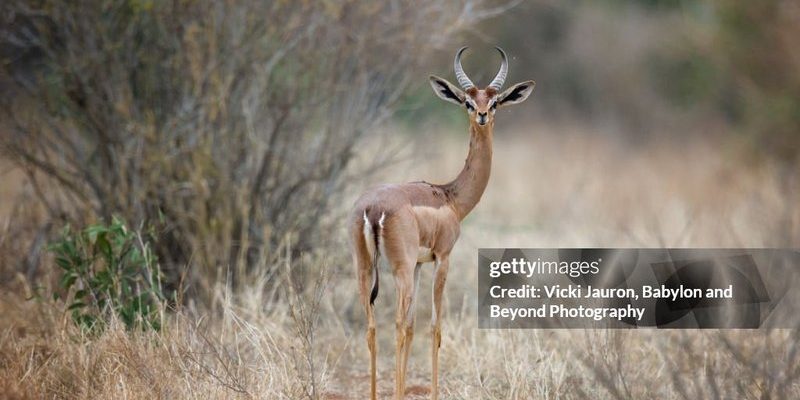
The geremuk, also known as the “long-necked antelope,” stands out among its peers not just for its appearance but also for its unique adaptations and evolutionary history. Understanding how these animals came to be what they are today helps paint a vivid picture of nature’s creativity and resilience. So grab your virtual safari gear, and let’s embark on this exploration together!
What is a Gerenuk?
Before we step into its history, let’s talk about what a gerenuk actually is. This antelope species, scientifically named *Litocranius walleri*, is native to the arid and semi-arid regions of East Africa, particularly in places like Kenya and Somalia. They’re easily recognizable thanks to their long necks, which can stretch up to 30 inches, and their slender bodies.
The gerenuk’s diet consists mainly of leaves, fruits, and flowers, which it reaches by standing on its hind legs. This behavior isn’t just quirky; it’s a smart survival tactic in a land where food can be scarce. By reaching for higher foliage, they avoid competition with more ground-dwelling grazers. Isn’t it fascinating how evolution molds behaviors based on environmental needs?
You might also notice their striking facial features, with large, expressive eyes and a distinctive set of curved horns in males. These traits not only make them beautiful but also play a role in survival. The horns are used for defense against predators and to establish dominance among males.
Evolutionary Background of the Gerenuk
To understand how the gerenuk evolved, it’s helpful to look back millions of years. The ancestors of modern antelopes began to diversify during the Miocene epoch, around 20 million years ago. This period saw a dramatic shift in climate and vegetation, which encouraged the evolution of various grazing animals.
The gerenuk’s lineage is thought to have diverged from other antelopes about 10 million years ago. They adapted to live in areas where water sources were limited, developing skills to browse on leaves rather than grazing on grass. This dietary shift allowed them to thrive in arid environments where other animals struggled.
Interestingly, the gerenuk’s long neck and legs are adaptations to escape predators and access food that would otherwise be out of reach. Picture it like a nature version of a tall person trying to reach the cookies on the top shelf! This evolution didn’t happen overnight; it was a gradual process shaped by environmental challenges and opportunities.
Physical Adaptations
The gerenuk is a master of adaptation. One of its most notable physical traits is that long neck, which allows it to reach higher branches. But there’s more to it than just looks.
– Long Legs: The gerenuk’s long legs enable it to cover large distances while searching for food and water. This is essential in their dry, expansive habitats.
– Flexible Diet: Unlike many other herbivores that stick to grasses, gerenuks are browsers. They can eat a wide variety of plants, which helps them survive when food is scarce.
– Camouflage: Their coat, which ranges from light brown to a reddish hue, helps them blend into their surroundings. This serves as an effective strategy against predators in the wild, like lions and hyenas.
These adaptations are not just fascinating; they highlight how the gerenuk has carved out a niche in its environment. It’s a reminder of how nature finds creative solutions to challenges, ensuring survival and diversity.
Social Behavior and Reproduction
Gerenuks are not just solitary creatures; they have interesting social behaviors too. Typically, you’ll find them in small groups, often consisting of a few females and their young, while males tend to be more territorial. They mark their territory with scent and will use their impressive horns to compete with other males during mating season.
During the mating period, males engage in displays of strength to attract females. This might involve bounding around or showcasing their height by standing tall on their hind legs. It’s almost a dance-off—nature’s version of impressing a date!
Once a female is ready to give birth, she’ll usually retreat to a secluded spot to have her calf. The young are born with a coat that blends in with the environment, providing them with some camouflage against predators. This protective strategy is crucial in the early days of life when they are most vulnerable.
Conservation Status and Threats
Despite their unique adaptations, gerenuks face several threats that impact their populations. Habitat loss due to human encroachment and agricultural expansion poses significant risks. As people convert land for farming, the space available for these beautiful antelopes shrinks, causing them to face tougher competition for resources.
Additionally, hunting for bushmeat and poaching impacts their numbers. In some regions, they’re hunted for their meat and hides, making conservation efforts even more critical.
Fortunately, there are various programs aimed at conserving gerenuk habitats and raising awareness. By working with local communities, wildlife organizations strive to protect these unique creatures and their environment. Conservation isn’t just about saving the gerenuk; it’s about preserving the intricate web of life in these ecosystems.
The Role of Gerenuks in Their Ecosystem
Gerenuks play an important role in their ecosystem beyond just being a species to observe. As browsers, they help maintain the health of their habitat. By feeding on leaves and twigs, they promote new growth and contribute to the overall biodiversity of the region.
Their presence also supports predator populations, as they are prey for larger carnivores. The balance of predator and prey keeps the ecosystem functioning smoothly. If gerenuks thrive, it’s a good indicator that the ecosystem is healthy, showcasing the interconnectedness of life.
In summary, the gerenuk’s evolutionary history isn’t just an interesting tale; it’s a clear example of how species adapt and thrive in their environments. There’s so much to appreciate about these animals, and their story continues to evolve as we learn more about them.
The gerenuk is more than just an antelope with a long neck; it’s a symbol of the wonders of evolution and adaptation in nature. From its unique feeding strategies to its social behaviors, every aspect of its life tells a story of survival in a challenging world.
As we learn about creatures like the gerenuk, it’s essential to recognize the importance of conservation efforts. Protecting their habitats and ensuring they can thrive is vital for maintaining the balance of their ecosystems.
So next time you think about the beauty of wildlife, remember the gerenuk and its incredible journey through evolution. It’s a reminder that every species has a story, and every story matters in the grand tapestry of life on Earth.

